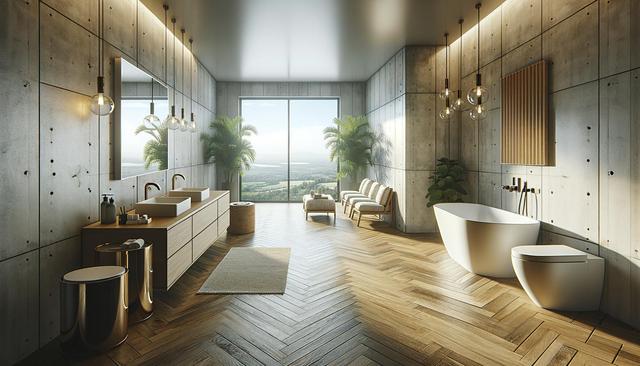
Bathroom Remodeling Trends to Watch in 2025
Nature-Inspired Design Elements
Bathrooms in 2025 are embracing the calming influence of nature. Organic materials, earthy tones, and biophilic design are making their way into modern homes. These trends are not just about aesthetics—they offer a way to create a relaxing, spa-like environment at home. Expect to see more natural stone tiles, wood accents, and indoor plants incorporated into bathroom spaces.
Popular features include:
- Stone vessel sinks with raw textures
- Wooden vanities with sustainable finishes
- Large windows or skylights for natural light
- Living walls or vertical gardens
This approach not only enhances the visual appeal but also contributes to improved air quality and a soothing ambiance. The focus on nature-inspired elements is part of a broader trend toward wellness-centered design, which is becoming a priority for many homeowners.
Smart Technology Integration
Technology continues to transform the way we use and interact with bathroom spaces. In 2025, smart features are becoming more intuitive, energy-efficient, and integrated into the overall design. From app-controlled showers to voice-activated lighting, convenience and customization are key drivers of this trend.
Some of the most sought-after smart upgrades include:
- Smart mirrors with built-in lighting, weather updates, and touch-free controls
- Toilets with automatic flushing, seat warming, and bidet functions
- Showers with digital temperature settings and water usage tracking
- Motion-sensor faucets and lighting systems
These innovations not only enhance comfort but also support sustainability goals by promoting efficient water and energy use. As more people look for ways to simplify their routines, integrating smart technology into bathroom remodeling projects is gaining popularity.
Sustainable Materials and Fixtures
Sustainability remains a central theme in bathroom remodeling for 2025. Homeowners are increasingly choosing environmentally friendly materials and systems that minimize waste and reduce ecological impact. This shift includes the adoption of water-saving fixtures, recycled materials, and low-VOC paints.
Key trends in this category include:
- Dual-flush toilets and low-flow showerheads
- Recycled glass or porcelain tiles
- Vanities made from reclaimed wood
- LED lighting that consumes less energy
These choices reflect a growing awareness of resource conservation and a desire to create healthier living environments. Whether you’re planning a full renovation or a few updates, incorporating sustainable elements can make a big difference in both environmental impact and long-term utility savings.
Bold Color Palettes and Finishes
While minimalism is still in style, 2025 welcomes bolder color choices and expressive finishes in bathroom design. Deep hues like navy blue, forest green, and terracotta are being used to add depth and personality to bathroom spaces. These colors are often complemented by metallic accents such as brushed gold, matte black, or antique bronze.
Designers are encouraging homeowners to personalize their bathrooms with:
- Colorful tile backsplashes or feature walls
- Statement sinks in non-traditional colors
- Contrasting grout lines for added visual interest
- Unexpected combinations of matte and glossy textures
This trend allows for greater creativity and expression, moving away from the all-white bathroom look that has dominated recent years. By mixing bold colors with high-quality materials, homeowners can achieve a look that’s both stylish and enduring.
Flexible Layouts and Multi-Functional Spaces
Modern bathrooms are evolving into multi-functional spaces that go beyond basic hygiene. In 2025, layouts are becoming more flexible to accommodate diverse needs—from wellness routines to family-friendly features. Open-concept showers, separate water closets, and dual vanities are some of the design solutions gaining traction.
Multifunctional elements include:
- Built-in seating for added comfort and utility
- Storage solutions that maximize vertical space
- Adjustable lighting for different moods and tasks
- Room dividers or screens for added privacy
This trend supports a more customized approach to design, allowing homeowners to create bathrooms that align with their lifestyle. Whether used as a tranquil retreat, a practical family space, or a wellness zone, flexible layouts help make the most of available square footage.
Conclusion
Bathroom remodeling in 2025 is all about blending functionality with personal style and environmental consciousness. By embracing natural materials, smart technology, sustainability, bold design choices, and flexible layouts, homeowners can create spaces that are both practical and inspiring. Whether you’re planning a modest upgrade or a full-scale renovation, these trends offer valuable ideas to guide your project in a direction that meets both current needs and future aspirations.